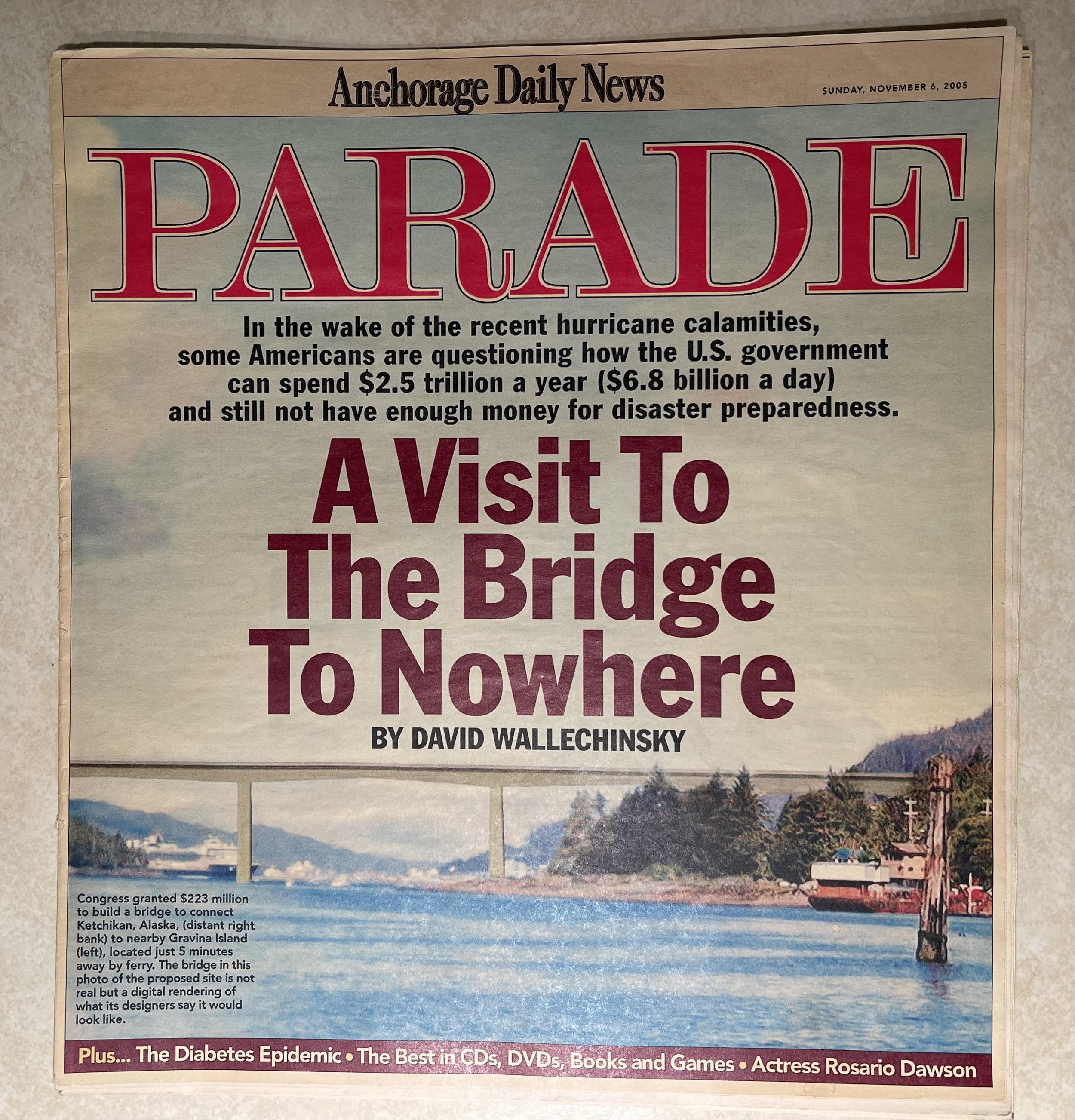Alaska and New Infrastructure Funds: We Promise Not to Waste It!
(Source: Author.)
The year was 2005 and Parade magazine, a publication distributed with Sunday newspapers nationwide, featured the southeast Alaska town of Ketchikan, population approximately 13,000, on its November 6 cover. The headline was “A Visit To The Bridge To Nowhere.”
Earlier in 2005, Alaska Senator Ted Stevens and Alaska Representative Don Young, senior lawmakers, put a $223-million earmark for the Ketchikan bridge and a $229-million earmark for Anchorage’s Knik Arm bridge into federal transportation law. These large sums were small fractions of the total costs for the bridges.
After spending approximately $40 million in federal and state dollars in planning and a three-mile road for the Ketchikan bridge, Governor Sarah Palin cancelled the project in 2007. That decision led her to tell national media after she was nominated to be John McCain’s running mate, “thanks but no thanks” to Congress for the earmark. Alaska also spent roughly $100 million in federal and state funds for the Knik Arm bridge which Governor Bill Walker cancelled in 2016. These Republican governors cancelled the bridges due to the state’s lack of matching funds to complete the projects and Alaska’s need to spend transportation money to repair existing roads and bridges.
In the mid-2000s, with these two “bridges to nowhere” and a “road to nowhere” proposed near Juneau, Alaska became the nation’s poster state for wasteful infrastructure spending. Since the federal government covered 90 percent of road and bridge project costs, despite the national embarrassment, Alaskans were okay with spending “free” federal money on infrastructure even if large amounts were wasted.
Now that President Biden signed the $1.2-trillion Infrastructure Investment and Jobs Act into law on November 15th, Alaska again is flush with federal infrastructure money. Alaska Senator Lisa Murkowski was a key legislator who developed the statute. Among its benefits, the infrastructure law will help the state’s rural regions obtain broadband and clean water. Senator Murkowski issued a seven-page bulleted list of the law’s Alaska highlights.
What do you do when an infrastructure avalanche is slated to hit your community?
Hop aboard the 2022 Local-Motive Tour to find out how to make the best use of federal and state funding!
Over half of the law’s new funds will go to transportation, $284 billion of $550 billion in new money. Roads and bridges are the largest portion of these transportation investments. Alaska’s funding for road and bridge projects will increase by approximately 26% to $3.7 billion over five years for roughly 5,600 miles of state roads and the state’s 845 bridges, many of which are structurally deficient. Alaska’s Marine Highway System of ferries, which currently is struggling financially, should receive hundreds of millions of dollars through a new $1 billion program for rural communities. The state’s airports will receive $392 million, plus the opportunity to compete for additional funding.
With this new infusion of federal infrastructure money, Alaska and other states need to avoid the spending mistakes made in the past, such as politicians announcing the start of costly transportation projects that the public does not need and does not want to pay to build or maintain. States should only fund transportation projects that have been thoroughly vetted by local and state planners and the public for success. It wasn’t easy for the Alaskan public to stop bridges and a road to nowhere, but persistent engagement utilizing volunteer and paid legal, economic, technical, and communications expertise eventually made the projects politically toxic.
So how can Alaska and other states ensure they spend the new federal transportation funds wisely? As the former head of the Alaska Transportation Priorities Project (ATPP), I recommend beginning with a vision for local and statewide transportation. In addition to maximizing transit and bicycling/walking opportunities, the vision should assume a climate-changed future, including remote workers who do not commute and electrified transportation systems.
As an example, Alaska non-profit organizations involved in transportation decision-making developed the following principles to incorporate into our state vision and specific projects:
Focus on maintaining existing roads and bridges rather than new infrastructure. Polling shows this is a political winner.
Ensure there is local support for proposed transportation infrastructure.
Make transportation planning and project development decisions in an open, transparent, and accountable manner.
Select and incentivize use of lower carbon transportation options.
Prioritize state spending on projects that benefit the public (e.g., pedestrian safety and transit), including low-income and Indigenous populations, rather than industry.
Protect fish and wildlife through infrastructure design, construction, and operations, including utilizing ferries instead of roads wherever possible to protect habitat.
As an engineer, I get it. New megaprojects are sexy to announce and build, while maintenance of existing infrastructure is not. Alaska is a largely rural state with a harsh climate, earthquakes, flooding, and permafrost thawing, however, and that means existing transportation infrastructure requires constant maintenance. The state has plenty of pressing road and bridge maintenance needs and a neglected ferry system—fixing those will keep transportation engineers and workers busy for many years. The new federal infrastructure funds represent a rare opportunity to address maintenance deficiencies while also implementing a forward-looking transportation vision.
Lois Epstein is an Alaska-licensed engineer who heads LNE Engineering and Policy consulting. She directed the nonprofit Alaska Transportation Priorities Project from 2007–2010 and is proud to point to places where wasteful bridges were not built due to her (and others’) efforts.



